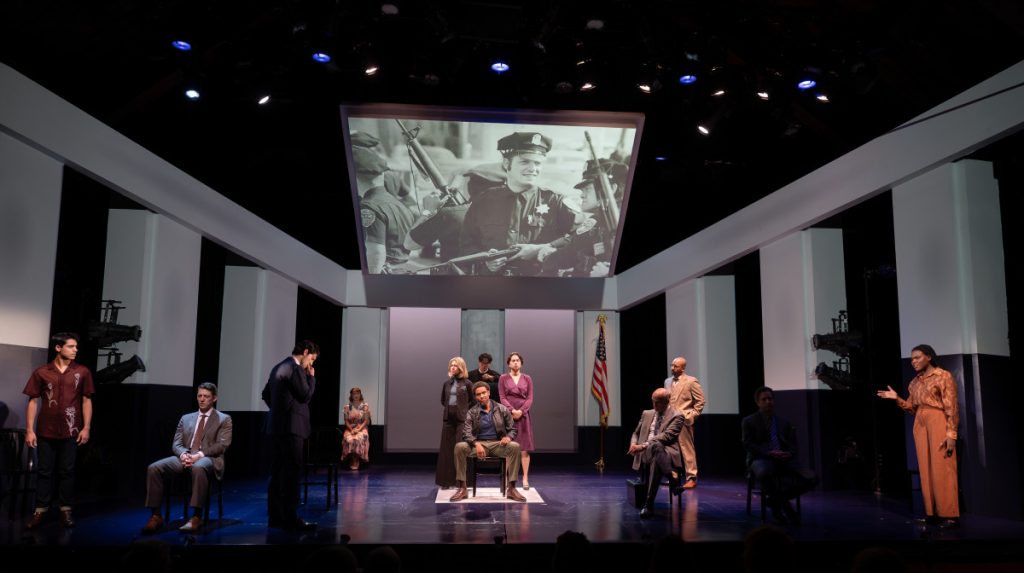
Julia Weber
Staff Writer
When the curtain rises on a play, audiences are immersed in live performance and art. What audiences might not realize, though, is that a play’s beginning isn’t just when the lights go down — that is the culmination of months of hard work.
Such is the case with Chautauqua Theater Company’s Execution of Justice, which continues its run of performances at 2 p.m. and 7:30 p.m. today in Bratton Theater. The play, written and directed by Emily Mann, follows the trial of former San Francisco city supervisor Dan White, who was convicted of killing former mayor George Moscone and former city supervisor Harvey Milk, California’s first openly gay elected official.
Brittany Vasta, scenic designer for the play, collaborated with CTC during the 2024 season to bring sets to life, and this year, she returns for Execution of Justice.
For Vasta, the work began months prior to opening night on July 16. Tasked with developing the environment of the play and cultivating the atmosphere of a courtroom, she began developing and workshopping floor plans and models that aligned with Mann’s creative vision.
“We talked a lot about the symbolic aspects of the play, the physical needs of the play (and) her preferences for staging,” she said.
As part of her extensive research process, Vasta spent time compiling notes from the play. She said she made a list of technical notes, things she found herself drawn to, repeated motifs and more, then sent this list to Mann to start developing a model of the set.
Meanwhile, John Narun, projections designer for Execution of Justice, was beginning his work coordinating projection imagery for the play. Like Vasta, he starts out with intense research, searching for documentary footage and resources he can use to understand a play as completely as possible in a way that he can then employ to immerse the audience.
Narun worked with Mann and the other designers throughout the process to determine what footage and cues would be shown in order to elevate the theatrical experience. He said that although it can be difficult for a viewer to delineate the differences between projection, lighting and design, the different concentrations often overlap and blend to envelop the viewer.
“It’s not always super straightforward to tell the difference between what is a projection and what is lighting and what is scenery,” Narun said. “We blur the lines between those things if we’re doing our jobs well.”
For Vasta, a big portion of the play was striking a balance between evoking the imagery and tension of a courtroom while simultaneously leaving the space flexible enough to transform into other places, such as a church and the streets of San Francisco. Narun was able to help transform the space through projection imagery.
“We wanted to create a space that felt like a courtroom, but was not a literal courtroom, because that might impede the sense of collage of voices and stories that need to move through the space,” she said.
The projections provide scene titles, photographs of courtroom evidence discussed at the trial, documentary footage of the events that unfolded during the trial and even live cameras filming characters in real time at the play. Through these varying effects, what is a stationary set design is transformed time and time again during the play to portray many scenes.
“One of the things that’s interesting about Execution of Justice is that we use multiple strengths of projection design that normally don’t exist simultaneously in a single production,” Narun said.
For Vasta, creative decisions like a rake stage — which slopes upward away from the audience, receding columns and an angled screen tilting downward toward the actors impose a forced perspective, further compounding the pressure and intensity of the play.
For both designers, the complexity and immensity of Execution of Justice provides a rich opportunity to tell a timely, relevant and crucial story for audiences through live theater.
“Execution of Justice is so wonderfully rich in terms of an environment to do projections because we have all of those different things happening simultaneously, which makes a really complex and big show to build,” Narun said.
Though the play tells the story of a specific historical event, Vasta believes its relevance endures.
“We see ourselves in the story, even if it’s a story we have not lived,” she said.




